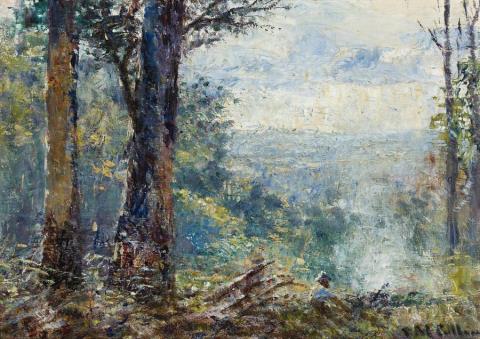THE CAMPFIRE, MOUNT MACEDON, c.1908-10
FREDERICK McCUBBIN
oil on canvas-board
25.5 x 35.0 cm
signed lower right: F McCubbin
Kozminsky Galleries, Melbourne (label attached verso)
Private collection, Melbourne
Sotheby's, Melbourne, 19 August 1996, lot 210
Private collection, Melbourne
'The feeling of closing day, approaching night and rest, the billy fire, and the smoke ascending from the burning gum branches typify so much of life along Victorian roads. It is thoroughly Australian.'1
Campfire paintings by Frederick McCubbin have their origins early in his work, Down on His Luck, 1889 (Art Gallery of Western Australia, Perth), and On the Wallaby Track, 1896 (Art Gallery of New South Wales, Sydney) being among his most admired paintings. The Campfire, Mount Macedon, while much later in date, continues the theme that begins in colonial times with its appeal of bush life and warm company by the glow of the fire. The location is now McCubbin's favourite, at Mount Macedon where he and his family settled in 1901. In those first years, McCubbin painted gently lyrical works in which the young members of his family were models, as in What the Little Girl Saw in the Bush, 1904 and Childhood Fancies, 1905. These subjects of bush fairies recall the tragic tale of children lost in the bush, now transformed into one of enchantment of subject matched by the play of light through the sylvan bush of Macedon. Happy and homely of inspiration, McCubbin was moving in the following years from narrative to a greater interest in atmospheric effects. While the tale lingered on in Sylvan Glade, Macedon, 1906 (Bendigo Art Gallery, Victoria), by 1910 in Hauling Rails for a Fence, Mount Macedon (National Gallery of Australia, Canberra) the two young figures become part of the colour composition.
Style and technique suggests that The Campfire, Mount Macedon was painted within this time span, about 1908 to 1910. The sparkle of light, colour, and greater spontaneity of handling recommends a date after 1907, when the impact of seeing J.M.W. Turner's paintings in England played such a creative role in McCubbin's art. While providing a humanising touch, the figure is no longer the focal point of the subject, nor the composition. Rather, the male figure (no longer a child) is now part of the overall composition, the underlying theme being the association of man and the environment, of his relationship to nature.
The earlier realism has given way to the freer Impressionist style, where the subject is the transient effects of nature, of changing light and colour. McCubbin loved the Macedon bush, as this painting shows so readily. As the enclosed foreground opens out into the distant panorama, the smoke of the fire blends with the haze of distance. The feeling of spontaneity that comes from painting en plein air gives it that special immediacy of appeal, in perfect harmony with the intimacy of the painting's size. This sparkling light, landscape and campfire are found again a few years later in Landscape, Macedon, c1914 (Art Gallery of New South Wales).
1. Frederick McCubbin, 'Some Remarks on the History of Australian Art', in MacDonald, J., The Art of Frederick McCubbin, Lothian Book Publishing, Melbourne, 1916, p. 86
DAVID THOMAS
